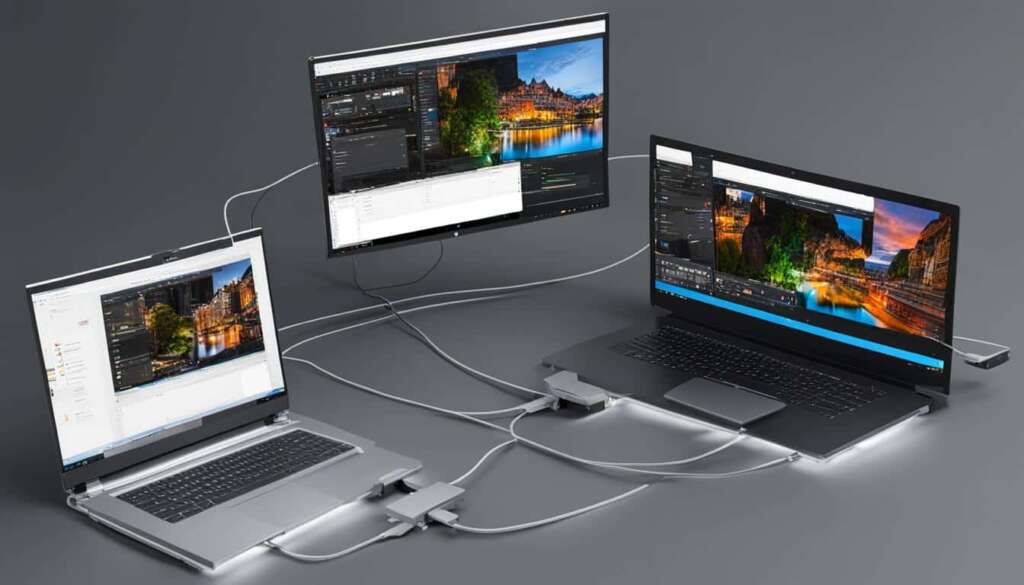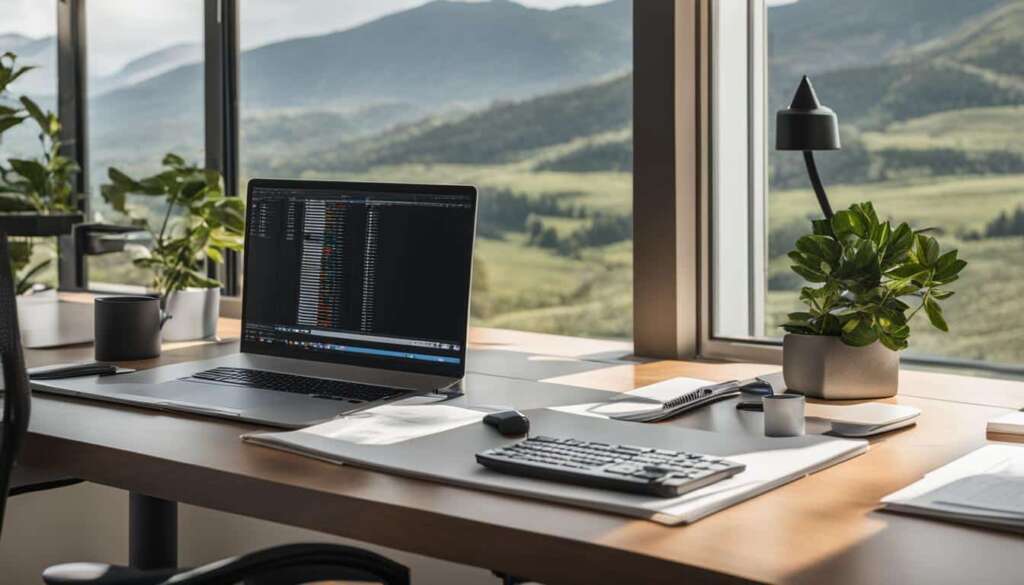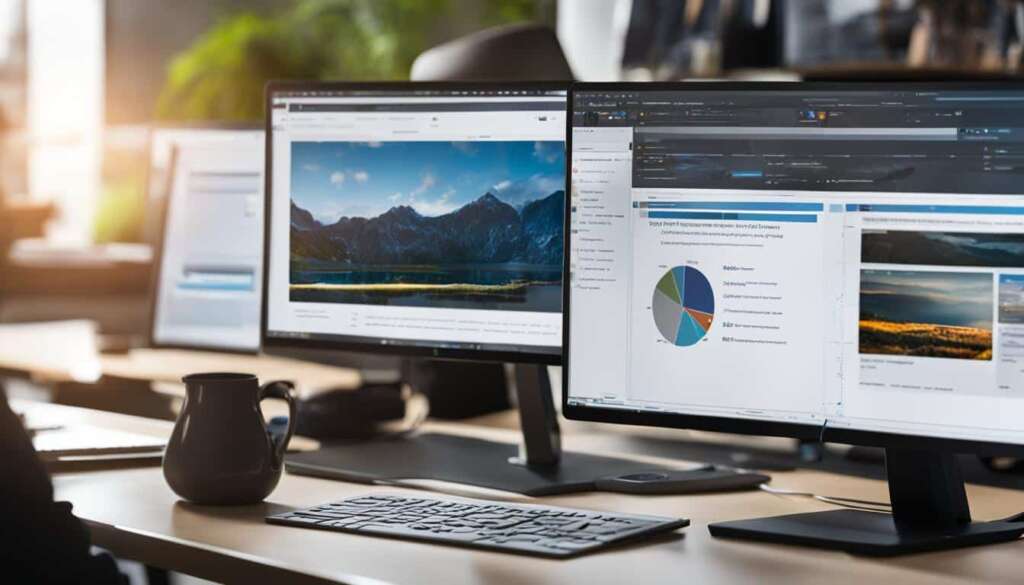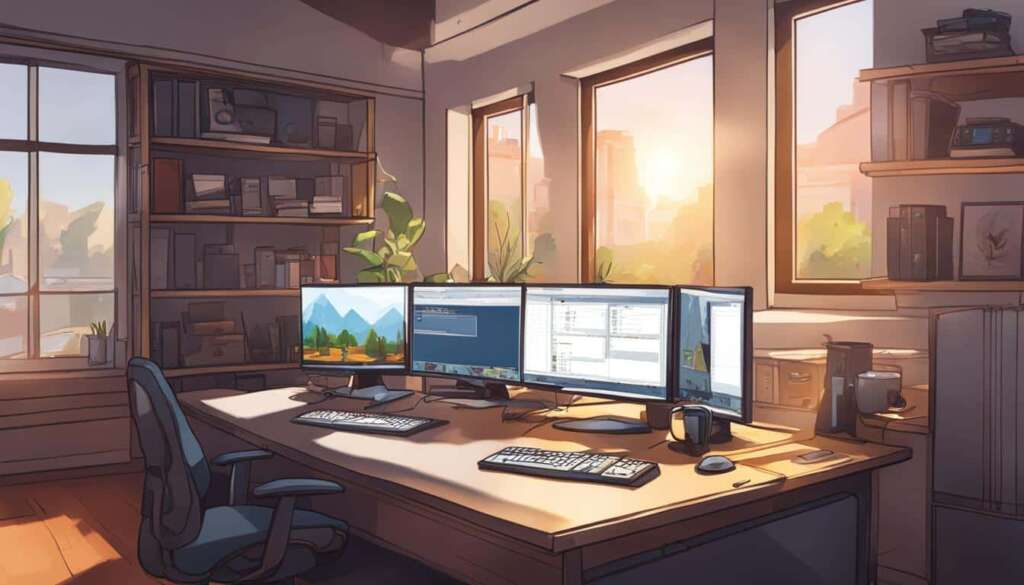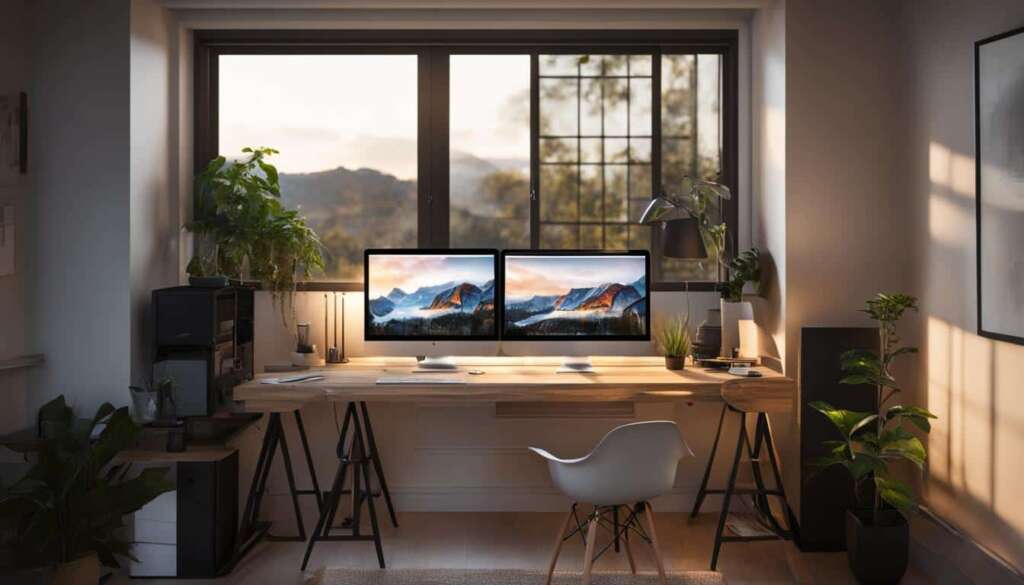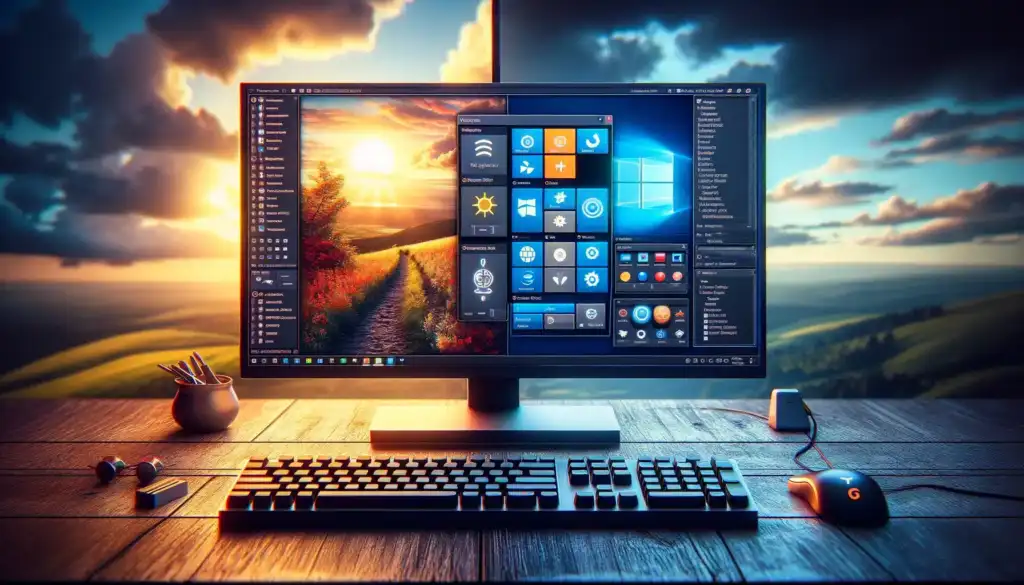Table of Contents
Are you looking to enhance your productivity and create a more immersive computing experience? Connecting two monitors to your laptop can open up a world of possibilities.
Imagine having a dual monitor setup that allows you to extend your display on your laptop, giving you the freedom to multitask seamlessly. Whether you’re a professional working on multiple projects, a gamer looking to expand your field of view, or a student needing to reference multiple sources simultaneously, a laptop dual monitor setup can transform the way you work and play.
In this article, we’ll guide you through the process of connecting two external monitors to your laptop, providing you with step-by-step instructions to set up your laptop dual monitor configuration. We’ll explore various options, including using HDMI, DisplayPort, USB-C hubs, and other methods, so you can find the best solution that suits your needs.
But first, let’s delve into the benefits of setting up a dual monitor system on your laptop:
- Increased Productivity: With a dual monitor setup, you can have multiple applications and documents visible at the same time, eliminating the need for constant tab switching or window resizing. This can significantly improve your workflow efficiency.
- Expanded Visual Workspace: Extending your laptop screen to two external monitors gives you a vast canvas to work with. Whether you’re editing videos, designing graphics, or working with spreadsheets, having more screen real estate allows for better organization and easier access to information.
- Reduced Eye Strain: By spreading out your workload across multiple monitors, you can minimize eye strain caused by prolonged screen time. With a larger display area, you can adjust font sizes and arrange windows to create a more ergonomic setup.
- Collaboration and Presentations: Dual monitors can be invaluable when collaborating with colleagues or giving presentations. With one monitor dedicated to content creation or reference materials, and the other focused on communication or presentation tools, you can engage with your audience seamlessly.
Now that you’re aware of the benefits, let’s dive into the step-by-step process of connecting two monitors to your laptop and setting up a dual monitor configuration that suits your needs.
Things to Check Before the Start
Before embarking on the process of connecting two monitors to your laptop and expanding your visual workspace, there are a few important things you need to check:
- Check your graphics card: To ensure seamless dual-monitor functionality, it’s essential to verify that your laptop’s graphics card supports multiple monitors. Visit the manufacturer’s website and review the specifications of your graphics card to confirm compatibility.
- Check available ports: Examine the ports on your laptop and ensure they are compatible with the connectors on your monitor cables. It’s crucial to match the port types, such as VGA, HDMI, DisplayPort, or USB-C, to the appropriate connectors on your monitors. If the ports don’t align, you may need to use adapters or explore alternative connection methods.
- Check compatibility: Verify that your laptop’s operating system is compatible with multiple monitors. Different operating systems, such as Windows or macOS, may have varying requirements and support levels for dual-monitor setups. Review the system requirements and compatibility guidelines for your specific operating system.
By conducting these checks before you start, you’ll ensure a smooth and successful setup process, setting the stage for an enhanced visual experience and increased productivity.
Graphics Card Compatibility
| Graphics Card Model | Multiple Monitor Support |
|---|---|
| NVIDIA GeForce GTX 1660 Ti | Yes |
| AMD Radeon RX 5700 XT | Yes |
| Intel UHD Graphics 620 | No |
| AMD Radeon R5 Series | No |
How to Set Up to Connect Two Monitors
Now that you have confirmed the compatibility of your laptop and monitors, it’s time to set up the connection. Follow these simple steps:
- Start by plugging the cable of the first external monitor into the appropriate video port on your laptop, such as VGA or HDMI.
- Next, connect the cable of the second external monitor to another available port on your laptop.
- With both monitors connected, right-click on an empty area of your desktop and select “Display settings.
- In the display settings menu, look for the option to extend the desktop to each monitor. Click on “Extend desktop to this display” under “Multiple displays.”
- You can then rearrange the displays by dragging and dropping them in the desired order. This allows you to position your monitors based on your physical setup.
- Additionally, you can adjust the size and resolution of each display to suit your preferences. This can be done in the display settings menu as well.
With these steps, you can seamlessly set up two monitors and enjoy an extended visual workspace on your laptop. The extended desktop feature allows you to have different applications and windows open on each monitor, greatly enhancing your productivity.
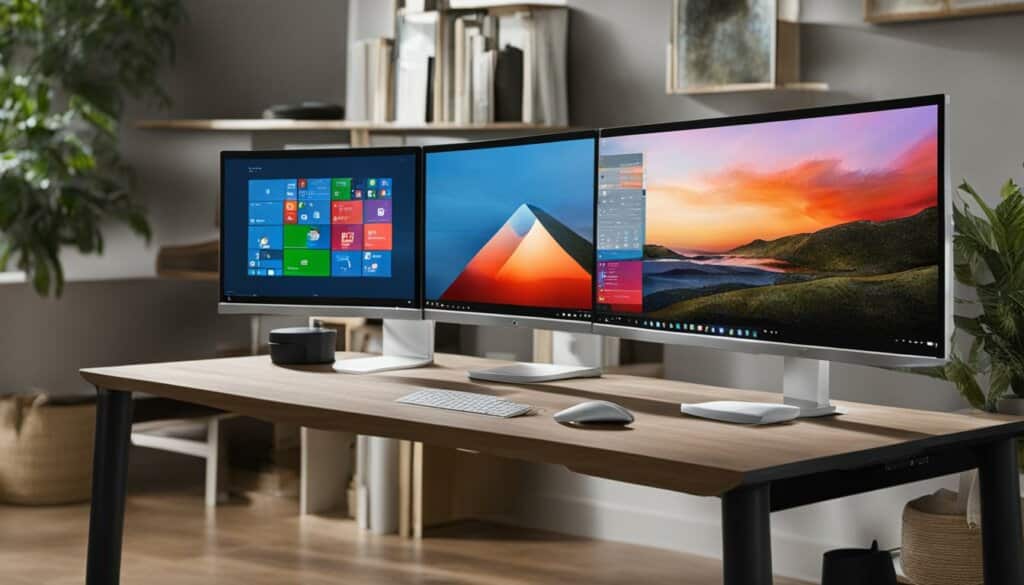
Troubleshooting: What if You Can’t See the Plugged-in Monitors
If you are experiencing issues where the plugged-in monitors are not visible, there are several troubleshooting steps you can take to resolve the problem.
Step 1: Check the Connection
First, ensure that the cables connecting your monitors to the laptop are properly and securely plugged in. Sometimes, an improper connection can prevent the monitors from being detected.
Step 2: Rule out Defective Hardware
If the issue persists, try using an alternative monitor and cable to rule out any defective hardware. By testing with different equipment, you can identify whether the problem lies with the monitor or the cable.
Step 3: Update Graphics Card Driver
If the monitors still cannot be detected after checking the connection and ruling out defective hardware, the issue may lie with the graphics card driver. Outdated or incompatible drivers can cause display problems.
To resolve this, we recommend updating your graphics card driver. You can do this manually by visiting the manufacturer’s website and downloading the latest driver for your graphics card model. Alternatively, you can use automated software such as Driver Easy to simplify the update process.
A visual representation of the troubleshooting process for plugged-in monitors not being visible.
Daisy Chaining: Connecting Monitors via DisplayPort
Looking for a seamless and efficient way to connect multiple monitors? Consider daisy chaining, a method that utilizes the power of DisplayPort technology. With daisy chaining, you can create a chain of connected monitors, eliminating the need for extra cables or adapters. Let’s explore how this method works and what you’ll need to set it up.
To begin, you’ll require monitors with DisplayPort In and Out ports, which allow one monitor to connect to another. Make sure your laptop or desktop is equipped with a DisplayPort Out or a USB-C port with DisplayPort support. These ports will serve as the starting point for your daisy chain connection.
With the hardware requirements met, it’s time to connect your monitors. Simply use DisplayPort cables to link each monitor in the chain. Begin by connecting the first monitor to your laptop or desktop using the DisplayPort cable. Then, use another DisplayPort cable to link the second monitor to the first one. By repeating this process, you can connect multiple monitors and create a chain.
Now that you have your monitors daisy chained, you can enjoy a seamless visual experience across all displays. Whether you’re working on multiple tasks, monitoring multiple applications, or collaborating with colleagues, daisy chaining provides an efficient solution for expanding your screen real estate.
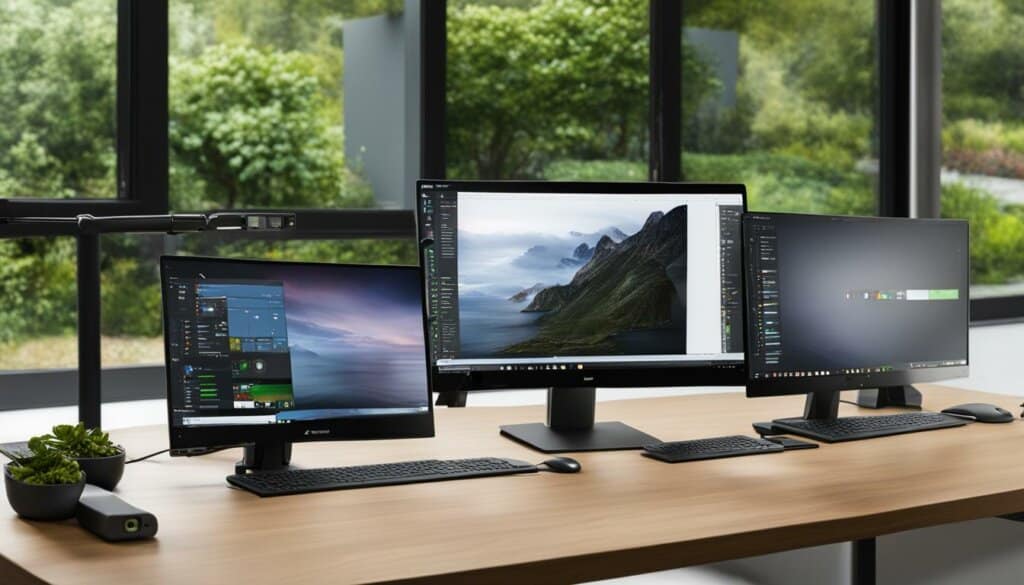
| Monitor | Port Type | Connection |
|---|---|---|
| Monitor 1 | DisplayPort Out | Connected to Laptop/Desktop |
| Monitor 2 | DisplayPort In | Connected to Monitor 1 |
| Monitor 3 | DisplayPort In | Connected to Monitor 2 |
Note: The number of monitors you can daisy chain depends on the capabilities of your graphics card and the monitor itself, so be sure to check the specifications beforehand for compatibility.
Daisy chaining with DisplayPort can simplify your cable management and provide a clutter-free setup. Enjoy the enhanced productivity and seamless multitasking that multiple monitors offer, all with a single cable connection.
Using USB C Hubs for Dual Monitor Setup
When it comes to achieving a dual monitor setup on a laptop with USB-C ports, USB C hubs are the answer. These versatile hubs come in various forms, such as USB C to HDMI adapters or USB C docking stations. By utilizing USB C hubs, you can expand the capabilities of your laptop and connect multiple monitors to enhance your productivity.
USB C hubs provide additional ports, including HDMI or DisplayPort outputs, that allow you to connect external monitors seamlessly. Whether you need to extend your display for a larger workspace or mirror your screen for presentations, USB C hubs make it simple and convenient.
With USB C hubs, you can effortlessly connect your laptop to dual monitors, even if your laptop doesn’t natively support this functionality. These hubs act as an intermediary between your laptop and the monitors, providing the necessary ports and connections for a smooth dual monitor setup.
Using a USB C to HDMI adapter is one popular option for connecting dual monitors. These adapters allow you to connect HDMI-enabled monitors to your laptop’s USB-C port. Simply plug the adapter into the USB-C port and connect your HDMI cable to the adapter and the monitor, and you’re ready to go.
USB C docking stations are another excellent choice for dual monitor connectivity. These docking stations provide a range of ports, including multiple USB, HDMI, and DisplayPort outputs. By connecting your laptop to the docking station, you can easily connect two monitors and enjoy the benefits of a dual monitor setup without the hassle of multiple cable connections.
In addition to the dual monitor connectivity, USB C hubs offer the convenience of additional USB ports, enabling you to connect other peripherals such as keyboards, mice, external hard drives, and more. This all-in-one solution simplifies your setup and reduces cable clutter.
Benefits of Using USB C Hubs for Dual Monitor Setup
Using USB C hubs for a dual monitor setup offers several advantages:
- Improved Productivity: With dual monitors, you can have multiple applications and documents open simultaneously, making multitasking much more efficient.
- Enhanced Multitasking: Dual monitors enable you to view and work on different tasks simultaneously, boosting your productivity and reducing the need to switch between windows.
- Expanded Visual Workspace: With a dual monitor setup, you have more screen space to organize your work, view multiple documents side by side, or compare information without constant resizing.
- Reduced Eye Strain: By spreading your workload across two monitors, you can minimize eye strain and maintain better posture, leading to increased comfort during long work sessions.
Other Methods of Connecting Dual Monitors
In addition to the methods mentioned above, there are other ways to connect dual monitors to a laptop. Here are a few alternative methods to consider:
1. Docking Station
A docking station is a convenient option that provides a centralized hub for connecting multiple monitors and peripherals to your laptop. With a docking station, you can easily connect your laptop to multiple monitors using the available ports on the dock. This eliminates the need to manually plug and unplug cables every time you want to connect or disconnect your monitors.
2. Video Splitter
A video splitter is another option for connecting dual monitors to your laptop. This device splits the video signal from your laptop and sends it to multiple monitors simultaneously. It allows you to duplicate the display on both monitors, making it useful for presentations or situations where you want the same content displayed on multiple screens.
3. Multiple Video Outputs
If your laptop has multiple video outputs, you can directly connect each monitor to a separate output. This method allows you to extend your desktop across multiple screens, giving you more screen real estate for multitasking. Some laptops have multiple HDMI or DisplayPort outputs, enabling you to connect multiple monitors without the need for additional hardware.
When choosing an alternative method for connecting dual monitors, consider your specific needs and the available ports on your laptop. Some laptops may require additional hardware or configurations to support these alternative methods.
Conclusion
Adding dual monitors to your laptop can have a transformative impact on your productivity and overall work experience. With a dual monitor setup, you can enjoy an expanded visual workspace that allows you to work more efficiently and effectively.
One of the key benefits of using dual monitors is the significant increase in productivity. By having two screens at your disposal, you can simultaneously view multiple applications, documents, or websites without constantly switching between them. This results in a streamlined workflow, saving you time and reducing distractions.
Moreover, a dual monitor setup can help reduce eye strain caused by prolonged screen time. By spreading out your work across two screens, you can minimize the need for excessive scrolling and zooming, leading to a more comfortable and ergonomic working environment.
In addition to these individual benefits, dual monitors also promote collaboration and multitasking. Whether you are collaborating with colleagues on a project or working on multiple tasks simultaneously, the dual monitor setup provides the space and flexibility needed to keep everything organized and within reach.
So, whether you opt for an HDMI, DisplayPort, or USB C hub connection, investing in a dual monitor setup is well worth the effort. Embrace the power of dual monitors, enjoy the increased productivity, reduce eye strain, enhance collaboration, and unleash your full potential in the world of multitasking.
FAQ
What are the things to check before connecting two monitors to a laptop?
Before starting the setup, ensure that your graphics card supports multiple monitors, check the available ports on your laptop, and verify the compatibility of your laptop’s operating system with multiple monitors.
How do I set up to connect two monitors to my laptop?
Start by plugging the first external monitor’s cable into the correct video port on your laptop, connect the second monitor’s cable to another available port, and then adjust the display settings to extend the desktop to each monitor.
What should I do if I can’t see the plugged-in monitors?
First, ensure that the cables are connected properly, then try using alternative monitors and cables. If the issue persists, update the graphics card driver manually or using software like Driver Easy.
How do I connect monitors via display port daisy chaining?
To daisy chain monitors, you need monitors with DisplayPort In and Out ports and a laptop or desktop with DisplayPort Out or USB-C with DisplayPort support. Connect the monitors using DisplayPort cables to create a chain with one monitor connected to another.
How can I use USB C hubs for a dual monitor setup?
You can use USB C hubs such as USB C to HDMI adapters or USB C docking stations. These hubs expand the connectivity options of your laptop by providing additional ports, including HDMI or DisplayPort outputs for connecting external monitors.
What are the other methods of connecting dual monitors to a laptop?
Other methods include using a docking station, which provides a centralized hub for connecting multiple monitors and peripherals, using a video splitter to split the video signal, or connecting each monitor directly to separate video outputs if your laptop has multiple ones.
What are the benefits of a dual monitor setup for a laptop?
A dual monitor setup can greatly improve productivity, reduce eye strain, and enhance collaboration by providing an extended visual workspace and the ability to multitask effectively.

